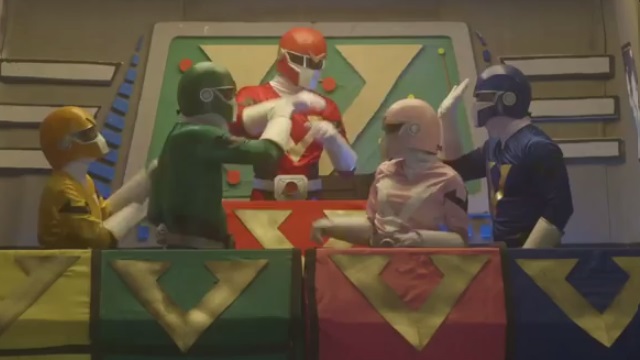SUMMARY
This is AI generated summarization, which may have errors. For context, always refer to the full article.

MANILA, Philippines – Director Miko Livelo has invented a time machine; made especially for a specific kind of traveler with a very specific purpose. Its destination: the early 90s, when afternoons were punctuated with merienda and television sets were locked to “Bioman.”
For those who fit Livelo’s intended audience, “Blue Bustamante” is an effective nostalgia trip to a time of Japanese-styled superheroes and building-sized monsters. But in the history according to Blue Bustamante, the heroes always win.
George Bustamante, however, doesn’t fashion himself a hero.
As a nameless stuntman of the hit Japanese television show “Force Five,” George (Joem Bascon) sees his job as nothing more than a means of providing for his wife June (Dimples Romana) and son Kiko (Jhiz Deocareza). Despite the theatrics of his profession, the soft-spoken George finds little thrill in fighting aliens and saving the world, especially when the world that matters is a thousand miles away.
Despite its dramatic underpinnings, Blue Bustamante doesn’t concern itself with the typical histrionics of OFW films. Melodrama is traded for punchlines, and the world of “Force Five” is brought to life in a flurry of make-believe sets and intentionally tacky special effects. But at its heart, “Blue Bustamante” is grounded by an endearing sentimentality that resonates among those who have grown up to the very same memories that Livelo brings to life.
In more ways than one, Livelo’s time machine works.
healthy helping of humor
“Blue Bustamante” takes its cue from popular Japanese culture, particularly the sentai television shows of the 80s and early-90s. But despite the film’s charmingly novel premise, Director Miko Livelo’s penchant for odd comedy is the true star of “Blue Bustamante.”
His knack for visual gags and off-tangent punchlines are a stretch from the usual commercial comedy puns. Livelo’s eccentric sense of humor relies heavily on spontaneity and improvisation, which ends up working well in a film whose set pieces revolve around cardboard cities and gaudily styled robots.
On screen, comedian-actor Jun Sabayton is a force of natural hilarity; offering a cross between creative and chaotic. Sabayton’s performance ends up as an odd complement to Joem Bascon’s own toned down portrayal of Bustamante.
But despite the film’s unpredictable brand of comedy, its consistent presence throughout the story provides levity to what could’ve easily been a heavy-handed melodrama. Livelo and co-writer Joel Ferrer take particular care in tiptoeing around the clichéd conflicts that weigh down the traditional OFW film. The result, in turn, is as a lighthearted and undoubtedly charming take on overseas foreign workers.
Watch the ’emotional version’ of the trailer here:
From zero to hero
Like the countless sentai shows it pays tribute to, “Blue Bustamante” is its own tale of transformation.
On the one hand there is the literal transformation of George into the body double of the iconic Blue Force – the cobalt tinted hero from “Force Five.” On the other hand, there is George’s own personal transformation from reluctant martyr to full-fledged hero.
At first, George sees little value in his make-believe world. He has long since outgrown any childhood predilection for robots and monsters, despite attempts of his friend Roger Grace (Jun Sabayton) to convince him otherwise.
But back in the Philippines, his son Kiko has made Force Five his own reality. Unknown to George, his son has come to idolize Blue Force. While George is quick to hide behind the mask of his television character, his son Kiko revels in it.
A Hero’s Journey
In a way, the film itself takes on a metamorphosis of its own. In its opening minutes, there is an awkward unsteadiness to the film. But as the story slowly gains momentum, we’re introduced to the vibrantly familiar world of Blue Bustamante.
Like the audience, the film transports George to his childhood. In this case, it is not through his own eyes, but through the eyes of his son. As he slowly discovers his son’s love for Force Five and George’s own Blue Force, he finds that he has forged a connection with his son that no distance can break. George’s own adult pretentions are slowly stripped away as he finds value to his work beyond his next pay check. He is a hero. He is his son’s hero. He is Blue Bustamante.
But despite its best intentions, “Blue Bustamante” is still a film with a particular audience in mind. For viewers who fail to grasph Livelo’s many time-bound allusions, his cinematic time machine may just be another obscure reference to a culture that has long passed its prime. But for audiences who have long imagined picking their favorite colored Bioman, “Blue Bustatamante” is an endearing ride with a single destination – childhood.
Watch the “wasaker” version of the trailer here:
– Rappler.com

Zig Marasigan is a freelance screenwriter and director who believes that cinema is the cure for cancer. Follow him on twitter at @zigmarasigan.
More from Zig Marasigan
Add a comment
How does this make you feel?
There are no comments yet. Add your comment to start the conversation.